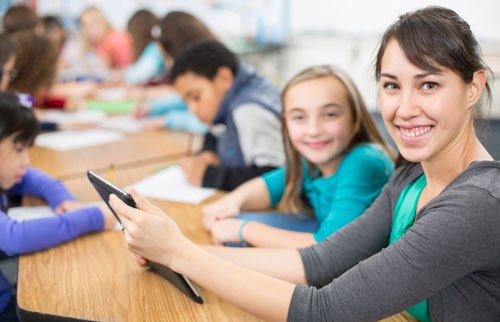It's no surprise some teachers fear social media in the classroom. Mastering social media is a tricky proposition for many schools, and the communication power of it is undeniable. Some teachers and school administrators are reluctant to embrace social media technology because they’re not sure how to use it effectively or how to set boundaries on its use.
Despite content management systems (like SchoolNow) and social media tools that have made it easy for schools to distribute content via social media, there's a social media phobia at work. And while teachers, administrators, students, and parents can often share content with just the click of a button, it's that ease of sharing content digitally that cuts both ways.
Even with effective social media tools, school administrators still have to first embrace the idea. Many school administrators are frankly paranoid about teacher scandals and violations of acceptable use policies. That leads to a “kid glove” approach. However, thought leaders in education are widely suggesting that the paranoia-driven approach is wrong and that schools should instead be actively integrating social media into their websites, lesson plans, and classrooms.
A recent survey from the University of Phoenix found that 47 percent of all K-12 teachers believed that social media could enhance learning and improve communication with parents. That number jumped to 58 percent when only considering high school teachers. Despite the widespread recognition of social media’s advantages, only 17 percent of surveyed teachers said they use social media in the classroom.
Why the reluctance to use social media? In light of the findings of the University of Phoenix study, U.S. News and World Report went looking for answers. Among the reasons why teachers and administrators aren’t embracing social media…
With social media becoming more popular in the last few years, it's often uncharted territory for teachers and they often have not set boundaries for its use," says Kathy Cook, the university's director of educational technology. "The line [between personal and professional] can become more blurred."
Controversy has surrounded teachers’ use of social media and whether posts -- both about students and about their personal lives -- can be used as grounds for termination.
It is true that some educators have had trouble separating their personal and private lives on social media. However, the University of Phoenix told U.S. News and World Report that teacher reluctance could be overcome with increased training.
According to the survey, teachers are more often using web tools, such as YouTube videos and podcasts, or other types of technology -- such as laptops, interactive whiteboards or tablets -- over social media tools.
Teachers might be more comfortable to use social media in the classroom, Cook says, if there was more comprehensive training available in school districts and teacher preparation programs.
One way to help teachers feel more comfortable with social media is to encourage the use of teacher or classroom web pages. Most content management systems (CMS) can generate teacher web pages within a school’s website with simple modules. These modules take the technological aspect out of the process and simply allow a teacher to simply focus on the page’s content. When they’re ready to share on Facebook or Twitter, they can do so with one click.
Schools that have embraced social media, however, have seen clear results. Many say that social media and digital technology have allowed parents to become more involved in their children’s learning. This is especially true in lower-income school districts. An article in Education Week highlighted how some schools are using digital learning and social media to engage with parents.
Digital learning levels the playing field among parents in a pretty profound way," said Elisabeth Stock, the chief executive officer and co-founder of CFY, or Computers for Youth, a New York City-based nonprofit that works with low-income communities and schools to improve digital literacy.
For low-income parents who feel they can no longer help their kids with learning as homework starts to become appreciably harder, access to high-quality digital learning content at home and the training to use it keeps these parents in the game," she said. "These parents can now easily find help online or learn side by side with their child."
The implementation of social media in a schools always works better when it starts at the top. Principals and other administrators who actually use social media themselves can help the idea gain traction with teachers, parents, and students. They can also set a good example for faculty on how to most effectively use social media. From the same article in Education Week…
When Principal Joe Mazza took on his position six years ago, he made it a priority to use digital technologies to improve communication between the school and parents. Today, the school—where 40 percent of the students are eligible for free or reduced-price lunch and 22 languages are represented—has grown from its first outreach effort of an email listserv to communicating with parents through Twitter, Facebook, a parent-school Wiki, virtual chat, blog, and a Google text line.
Even regular check-ins on Twitter can help teachers and parents feel more engaged…
In California's 26,000-student Vista school district, 40 miles north of San Diego, Superintendent Devin Vodicka decided when he took the job this past summer to use social media to improve district communication with parents and staff members. Mr. Vodicka started a Twitter account and began making the rounds to schools, with the goal of reaching every classroom in the district and tweeting his experiences at each to his Twitter followers.
Other administrators in the district have followed Mr. Vodicka's lead—now, 60 administrators have school-related Twitter and Facebook accounts, and around three-quarters of the schools now have some kind of social-media presence.
It’s clear, though, that even with strong support from school administrators, teachers are unlikely to use social media in the classroom until they are comfortable with how exactly how to use it. Eighty-percent of the teachers in the University of Phoenix survey said that one of the reasons they don’t use social media is that they don’t know how to do so in a professional setting. They particularly mentioned that they don’t know how to separate their private lives from the professional lives online.
Phoenix Forward magazine recently shared a few tips on how teachers can do just that….
1) Set a good example. It’s not enough now to teach students their lessons and how to be productive members of society, Cook says.
2) Create a class Facebook page. On the Facebook® social network, teachers can build pages for their classes that they can use for “communicating class announcements, class activities and assignment deadlines, etc.,” Cook says.
3) Establish online guidelines. “It is important that class pages are constantly monitored by teachers," Cook says. “If there are inappropriate comments or posts, they can be removed, and the offender can be restricted from posting but not viewing in the space in the future.”
4) Devise a Twitter “channel.” The Twitter® microblogging service, with its 140-character limit, is a good choice for teachers who want to deliver short bursts of information to students or help them practice concise writing.
There are also a few teachers who are leading the charge. Vicki Davis, a teacher from Camilla, Georgia, recently wrote on Edutopia about how teachers can use social media effectively:
- Tweet or post status updates as a class. Teacher Karen Lirenman lets students propose nuggets of learning that are posted for parents to read.
- Use Facebook to get feedback for your students' online science fair projects. Teacher Jamie Ewing is doing this now, as he shared recently.
- Use YouTube for your students to host a show or a podcast. Don Wettrick's students hosted the Focus Show online and now share their work on a podcast.
- Create Twitter accounts for a special interest projects. My student Morgan spent two years testing and researching the best apps for kids with autism (with the help of three "recruits"), and her work just won her an NCWIT Award for the State of Georgia.
- Further a cause that you care about. Mrs. Stadler's classes are working tosave the rhinos in South Africa, and Angela Maiers has thousands of kids choosing to matter.
Ms. Davis’s final point is maybe the most important.
If you're going to ignore social media in the classroom, then throw out the ISTE Standards for Students and stop pretending that you're 21st century. Stop pretending that you're helping low-income children overcome the digital divide if you aren't going to teach them how to communicate online.
Social media is here. Students are going to use it regardless of whether the school does. Administrators and teachers can teach them the right way to use social media by bringing it into the classroom.
Are you afraid of using social media in your classroom? How do you use it?
Topics: School Districts Private schools Social media
About the author
Marketing director and content strategist for SchoolNow, Jay’s a former school public relations specialist who’s helped businesses, schools and colleges use the power of communications to improve their image, generate support, and optimize relationships. Reach him at jay@schoolnow.com.
.png?width=64&height=63&name=Group%20(4).png)
.png?width=66&height=64&name=Group%20(5).png)
.png?width=56&height=60&name=Group%20(6).png)
.png?width=66&height=52&name=Group%20(7).png)
.png?width=56&height=56&name=Group%20(9).png)
.png?width=59&height=52&name=Group%20(10).png)



